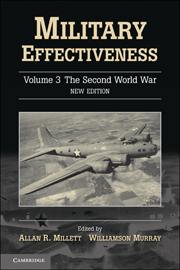Book contents
- Frontmatter
- Contents
- List of Contributors
- Introduction: Military Effectiveness Twenty Years After
- Maps
- 1 The Effectiveness of the Japanese Military Establishment in the Second World War
- 2 The United States Armed Forces in the Second World War
- 3 British Military Effectiveness in the Second World War
- 4 The Italian Armed Forces, 1940–3
- 5 The Dynamics of Volksgemeinschaft: The Effectiveness of the German Military Establishment in the Second World War
- 6 Bitter Victory: French Military Effectiveness during the Second World War
- 7 The Soviet Armed Forces in the Great Patriotic War, 1941–5
- 8 Military Effectiveness in the Second World War
- 9 Challenge and Response at the Operation and Tactical Levels, 1914–45
- 10 The Political and Strategic Dimensions of Military Effectiveness
- Index
5 - The Dynamics of Volksgemeinschaft: The Effectiveness of the German Military Establishment in the Second World War
Published online by Cambridge University Press: 05 June 2012
- Frontmatter
- Contents
- List of Contributors
- Introduction: Military Effectiveness Twenty Years After
- Maps
- 1 The Effectiveness of the Japanese Military Establishment in the Second World War
- 2 The United States Armed Forces in the Second World War
- 3 British Military Effectiveness in the Second World War
- 4 The Italian Armed Forces, 1940–3
- 5 The Dynamics of Volksgemeinschaft: The Effectiveness of the German Military Establishment in the Second World War
- 6 Bitter Victory: French Military Effectiveness during the Second World War
- 7 The Soviet Armed Forces in the Great Patriotic War, 1941–5
- 8 Military Effectiveness in the Second World War
- 9 Challenge and Response at the Operation and Tactical Levels, 1914–45
- 10 The Political and Strategic Dimensions of Military Effectiveness
- Index
Summary
Introduction
The assumptions and conditions under which the Wehrmacht functioned after 1939 were heavily shaped by a cultural tradition that dates back to Imperial Germany. Since the German state had been founded by the army, the army was a major national institution, and military service an almost universal obligation. Not only did soldiers dedicate themselves to an exultation of military values, but the system of subordination and autocracy was widely accepted, and an authoritarian attitude predominated. The National Socialist regime did not have to invent the glorification of war as a corporate experience, dismantling social and educational barriers and uniting the whole nation except for those who, with the help of Bolshevism, had stabbed the victorious army in the back. The ‘battle as an inner experience’ (Fronterlebnis) was not a mere literary convention in Germany. It became the pivot for the amalgamation of national socialism and the German soldierly tradition.
It was General Werner von Blomberg, Hitler's Minister of War, who stated in an educational directive on 24 May 1934 that the ‘ideas of both our soldiery and National Socialism spring from the common experience of the Great War.’ The bond between the military and the movement was the ‘idea of a community of blood and destiny of all German people.’ The political goal of a militarized Volksgemeinschaft incorporated the ideas of self-sacrifice and the elimination of foreigners. In 1935 universal conscription for Aryans was decreed as a duty for the German people. In 1938 the German's honor was defined as allegiance to the Führer and the people.
- Type
- Chapter
- Information
- Military Effectiveness , pp. 180 - 220Publisher: Cambridge University PressPrint publication year: 2010
- 1
- Cited by

